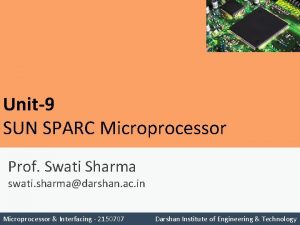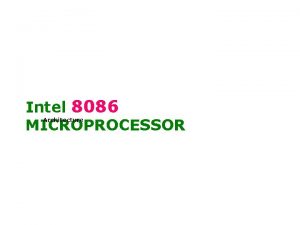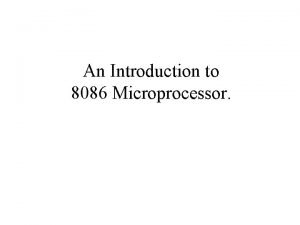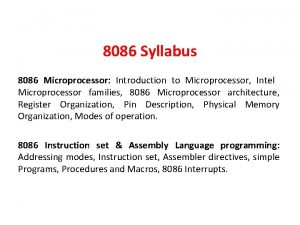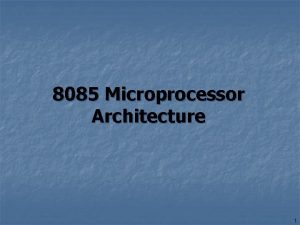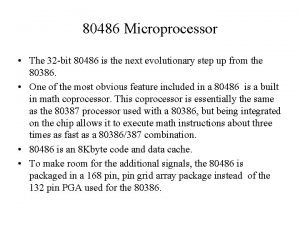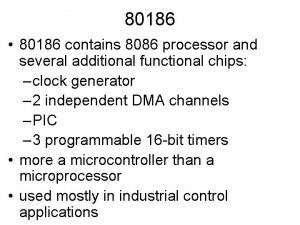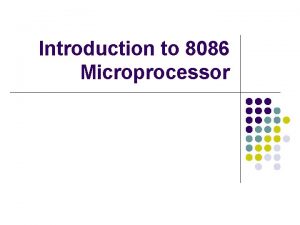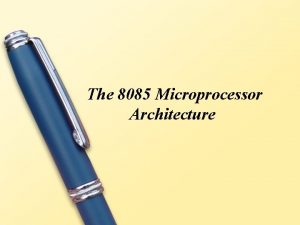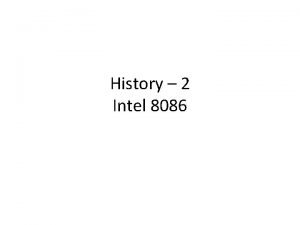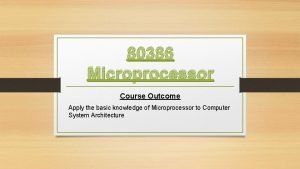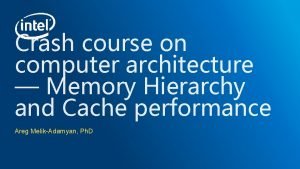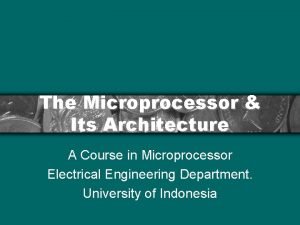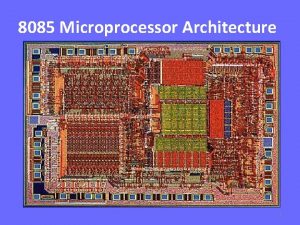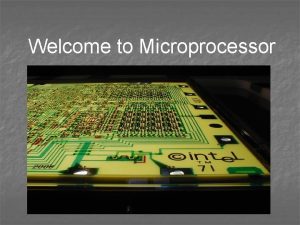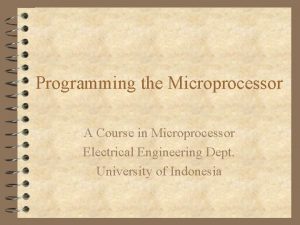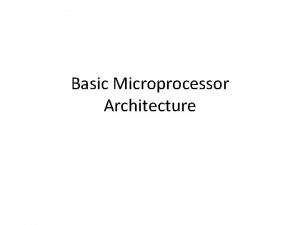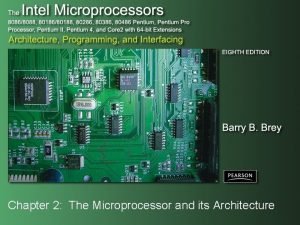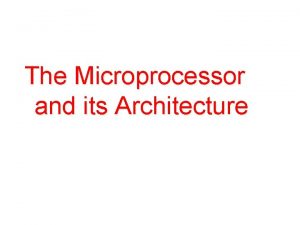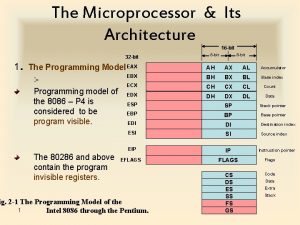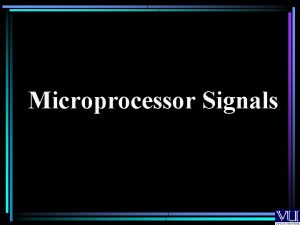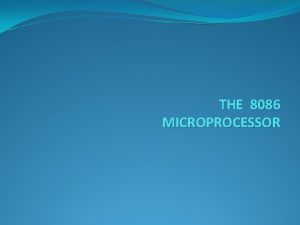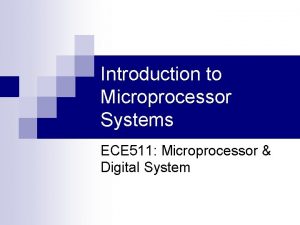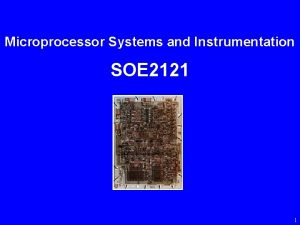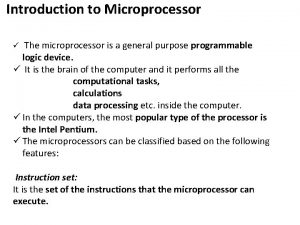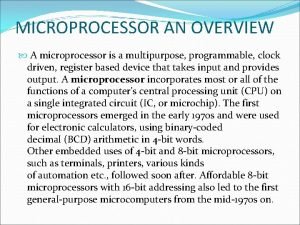The Microprocessor Its Architecture A Course in Microprocessor























- Slides: 23

The Microprocessor & Its Architecture A Course in Microprocessor Electrical Engineering Department Universitas 17 Agustus 1945 Jakarta

Objectives • Describe the function and purpose of each program-visible & program-invisible register • Detail the flag register and the purpose of each flag bit • Describe how memory is accessed using real mode memory-addressing techniques • Describe how memory is accessed using protected mode memory-addressing techniques • Details the operation of the memory paging mechanism

Internal µP Architecture • The programming model of the 8086 through the Pentium Pro is considered program visible because its registers are used during programming and are specified by the instructions • Other registers are considered program invisible because they are not addressable directly during applications programming, but may be used indirectly during system programming

Internal µP Architecture (cont’d) • Fig. 2. 1 depicts the programming model of the 8086 - Pentium Pro microprocessor • The earlier 8086/8/286 contain 16 -bit while 80386/486/Pentium/Pro contain full 32 -bit internal architecture • The multipurpose register include EAX, EBX, ECX, EDX, EBP, EDI, and ESI – EAX (accumulator) is used for instructions (e. g. , multiplication, division, and some of adjustment instructions) and may hold the offset address of a location in the memory

Internal µP Architecture (cont’d) – EBX (base index) registers sometimes hold the offset address of a location in the memory system – ECX (count) holds the account for various instructions – EDX (data) holds a part of the result from a multiplication or a part of the dividend before a division – EBP (base pointer) points to a memory location – EDI (destination index) addresses string destination data for the string instructions

Internal µP Architecture (cont’d) – ESI (source index) addresses source string data for the string instructions • Special Purpose Registers include EIP, ESP, EFLAGS and the segment registers CS, DS, ES, SS, FS, and GS – EIP (instruction pointer) points to the next instruction in a program and is used to find the next sequential instruction in a program located within the code segment – ESP (stack pointer) addresses an area of memory called the stack

Internal µP Architecture (cont’d) – EFLAGS indicate the condition of the microprocessor as well as control its operation (Fig. 2. 2) • C (carry) holds the carry after addition or the borrow after subtraction • P (parity) is a logic 0 for odd parity and a logic 1 for even parity. Parity is a count of ones in a number expressed as even or odd • A (auxiliary carry) holds the carry (half-carry) after addition or the borrow after subtraction between bits position 3 and 4 of the result • Z (zero) flag shows that the result of an arithmetic or logic operation. Z=1, if the result is zero. Z=0, if the result is not zero.

Internal µP Architecture (cont’d) • S (sign) flag holds the arithmetic sign of the result after an arithmetic or logic instruction executes. • T (trap) flag enables trapping through an on-chip debugging feature • I (interrupt) flag controls the operation of the INTR (interrupt request) input pin • D (direction) flag selects either the increment or decrement mode for the DI and/or SI register during string instructions • O (overflow) flag indicates the result of addition or subtraction has exceeded the capacity of the machine • IOPL (I/O privilege level) is used in protected mode operation to select the privilege level for I/O devices

Internal µP Architecture (cont’d) • NT (nested task) flag indicates that the current task is nested within another task in protected mode operation • RF (resume flag) is used with debugging to control the resumption of execution after the next instruction • VM (virtual mode) flag bit selects virtual mode operation in a protected mode system • AC (alignment check) flag bit activates if a word or a doubleword is addressed on a non-word or a nondoubleword boundary • VIF (Virtual Interrupt Flag) is a copy of the interrupt flag bit available to the Pentium/Pro µP • VIP (Virtual Interrupt Pending) provides information about a virtual mode interrupt for the Pentium/Pro µP

Internal µP Architecture (cont’d) • ID (identification) flag indicates that the Pentium/ Pro µP support the CPUID instruction • Segment Registers are additional registers which generate memory addresses when combined with other registers in the µP – CS (code) is a section of memory that holds the code (programs and procedures) used by the µP The code segment register defines the starting address of the section of memory holding code – ES (extra) is an additional data segment used by some of the string instructions to hold destination data

Internal µP Architecture (cont’d) – DS (data) is a section of memory that contains most data used by a program. Data are accessed in the data segment by an offset address or the content of other registers that holds offset address – SS (stack) defines the area of memory used for the stack. The BP register also addresses data within the stack segment

REAL MODE MEMORY ADDRESSING • The 80286 or above operate in either the real or protected mode • Real mode operation allows the µP to address only the first 1 MB of memory space (the real memory or conventional memory) • A combination of a segment address and an offset address access a memory location in the real mode • The segment address defines the beginning address of any 64 K-byte memory segment

REAL MODE MEMORY ADDRESSING (cont’d) • The offset address selects any location within the 64 KB memory segment (Fig. 2. 3) • In the real mode, each segment register is internally appended with a 0 H on its rightmost end. This forms a 20 -bit memory address, allowing it to access the start of a segment at any 16 -byte boundary (a paragraph) within the first 1 MB of memory (i. e. requires 20 -bit memory address)

REAL MODE MEMORY ADDRESSING (cont’d) • The µP has a set of rule that apply to segment whenever memory is addressed – The code segment register is always used with the instruction pointer to address the next instruction in a program (CS: IP or CS: EIP) • The code segment register defines the start of the code segment and the instruction pointer locates the next instruction within the code segment • This combination locates the next instruction executed by the microprocessor

REAL MODE MEMORY ADDRESSING (cont’d) – Another of the default combination is the stack • Stack data are referenced through the stack segment at the memory location addressed by either the stack pointer (SP/ESP) or the base pointer (BP/EBP) • The combinations are referred to as SS: SP or SS: BP – Other default are shown in Table 2 -2 (16 -bit registers) and Table 2 -3 (32 -bit registers) • The 8086 -286 allow four memory segments, and 80386 and above allow six memory segments (fig. 2. 4) • Fig. 2. 5 shows how an application is stored

REAL MODE MEMORY ADDRESSING (cont’d) • The segment and offset addressing scheme allows both program and data to be relocated without changing anything in the programs or data – Because the memory is addressed within a segment by an offset address, the memory segment can be moved to any place in the memory system without changing any of the offset addresses, i. e. , by moving the entire program as a block to a new area and then changing only the contents of the segment registers







 Half brick wall vs one brick wall
Half brick wall vs one brick wall Course number and title
Course number and title Course interne moyenne externe
Course interne moyenne externe Sun sparc microprocessor architecture
Sun sparc microprocessor architecture Eu and biu in microprocessor
Eu and biu in microprocessor Introduction to 8086 microprocessor
Introduction to 8086 microprocessor Introduction to 8086
Introduction to 8086 8085 microprocessor block diagram
8085 microprocessor block diagram 80486 microprocessor architecture
80486 microprocessor architecture 80186 vs 8086
80186 vs 8086 Architecture of 8086
Architecture of 8086 The intel 8088 is a variant of the intel 8086
The intel 8088 is a variant of the intel 8086 80286 microprocessor architecture
80286 microprocessor architecture 8085 architecture
8085 architecture 8086 architecture
8086 architecture What are the features of 80386
What are the features of 80386 Gpu architecture course
Gpu architecture course Computer architecture crash course
Computer architecture crash course Emigree poem
Emigree poem When a train increases its velocity its momentum
When a train increases its velocity its momentum Sunny cloudy windy rainy
Sunny cloudy windy rainy If its square its a sonnet
If its square its a sonnet Its halloween its halloween the moon is full and bright
Its halloween its halloween the moon is full and bright Its not easy but its worth it
Its not easy but its worth it



